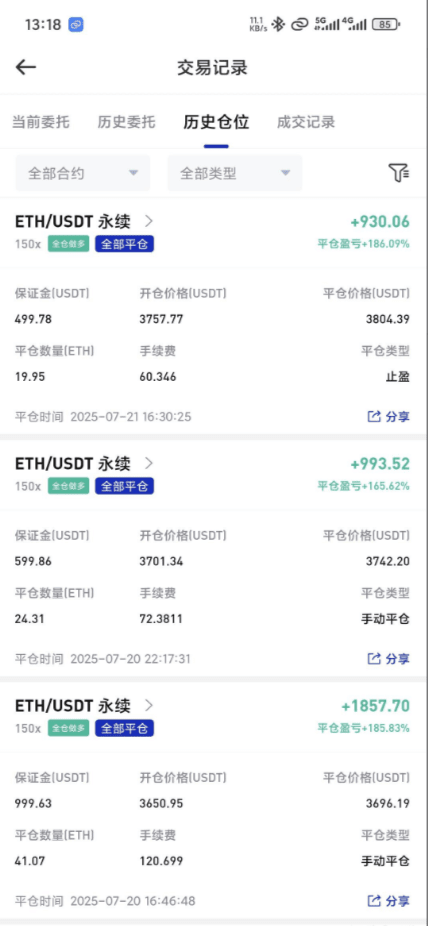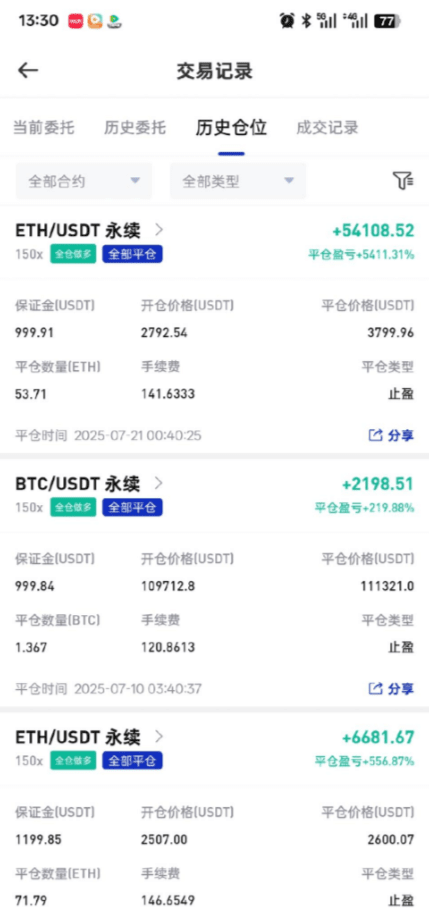I have seen someone turn 5000 into 1 million in half a year, and I've also seen someone make 500,000 one day and lose it all the next — this isn't a matter of luck, but the stark difference in the execution of rolling strategies. After 4 years of practical experience in contracts, I have encountered enough pitfalls to fill a truck. The summary of this strategy boils down to two words: 'Guard' and 'Ruthless' — be as stable as a mountain when it's time to guard, and never hold back when it's time to be ruthless.
1. Wait: 90% of the time waiting, 10% of the time earning.
As a beginner in contracts, I always feel that 'not trading is losing'. I feel uncomfortable if I don't open a position in a day. But the people I have seen making money are all 'snipers' — they stay still 90% of the time, waiting for the best moment to pull the trigger.
Last year, a fan started with 5000, traded every day for the first three months, spent over 800 on fees, and lost 30% of the account. Later, he learned from me to 'wait for the market', only acting when BTC or ETH experienced a 'violent market': for example, breaking through a key resistance level or rising more than 5% in volume. As a result, in the fourth month, he made 40% on one trade, equivalent to the chaotic attempts of the previous three months.
What is a 'violent market'? There are three signals:
Breakthrough key levels + volume: BTC was horizontal for half a month at 30,000, suddenly breaking through 32,000 with a large bullish candle, and the trading volume was three times that of the previous day — this means 'capital is seizing the opportunity', entering at this time, there's a high probability of more than 10% volatility within three days.
Trends driven by news: When major announcements like the Fed announcing interest rate cuts or Bitcoin halving come out, the market often continues for a period. On the day the Fed cut rates last year, I waited for 2 hours to confirm the trend before entering, making a 30% profit in 5 days.
Sector-linked upward movement: For example, if the DeFi sector rises collectively, and the leading coin rises by 10%, other coins follow — this indicates 'it's not just a single coin's market, but a sector opportunity', which is safer.
The core of waiting for the market is 'resisting the urge to act'. I have a timer on my phone, forcing myself to 'open at most 2 positions a day', and before opening a position, I must watch the K-line for 15 minutes; many impulsive trades are suppressed this way. Remember: in the contract market, missing 10 opportunities is not scary; what's scary is one impulsive move that wipes out your capital.
2. Roll: Use profits to roll, capital is always the 'safety cushion'.
'Adding positions after making money' is a fatal flaw for contract beginners. I once made a 50% profit on ETH, and in a moment of excitement, I added all my capital and profits, only for the market to reverse. Not only did I lose all my profits, but I also lost 20% of my capital. It was only later that I understood: capital is 'life', and profit is 'the icing on the cake', they cannot be conflated.

Now my operational principle is:
First trade profit, take out capital: With 5000 capital, I earned 1000 on the first trade (20%), and immediately transferred the 5000 capital out, only using the 1000 profit to continue trading. This way, even if I lost everything later, I would only lose the money I made, with no loss to my capital.
Rolling profits, adding positions in steps: When profits reach 2000 (doubled), add a maximum of 50% position (1000); when it reaches 4000, add another 50% (2000). Always leave a 'buffer zone' for profits, and don't put all your eggs in one basket.
Leave a safety cushion after doubling: When profits double (for example, 1000 becomes 2000), immediately take out 30% (600) into a stablecoin wallet, and continue rolling the remaining 1400. This 600 is the 'safety cushion', even if you lose later, you have genuinely secured 600.
Last year, there was a month when I rolled over 10,000 in profit, doubled it twice during the process, took out a 30% safety cushion, and even with market corrections, I netted a profit of 12,000 — many people fail to make money because they treat 'paper profits' as 'actual gains', not understanding the importance of 'locking in profits'.
3. Adjust: Move the stop-loss line with the profit, do not make a 'roller coaster'.
'After making 50%, move the stop-loss line up to the cost price' — this is a lesson I learned after losing 30,000.
When I first started trading contracts, I always set the stop-loss line fixed at 3% below the opening price. As a result, one time ETH retraced from a 50% profit to a 10% profit, and I didn’t act, thinking 'it can bounce back'. Eventually, it dropped to the stop-loss line, and not only did I lose all the profits, but I also lost 3%.
Now I have learned 'dynamic stop-loss adjustment':
Floating profit within 50%, set the stop-loss line 3% below the opening price (regular stop-loss).
Floating profit over 50%, move the stop-loss line to 'opening price' (cost price) to ensure 'no loss of capital'.
Floating profit over 100%, move the stop-loss line to 'opening price + 50%' to lock in half the profits.
Once, when SOL had a floating profit of 80%, I moved the stop-loss line to the cost price. Later, it retraced 2% above the cost price, but I didn't stop-loss, and it eventually rose 50% — I not only preserved the profit but also didn't miss the market. The core of this move is 'let profits protect themselves', earning more when it rises and not losing when it falls, maintaining a steady mindset.
4. Stop: Not being able to hold onto profits is equivalent to earning nothing.
'Not taking profits leads to the final loss' — this is the harsh truth of the contract market. I have seen too many people unwilling to sell when their positions are floating profits of 50% or 100%, only for the market to reverse, wiping out all profits, or even leading to losses.
My profit-taking principle is 'take profits in batches, and lock in gains when good'.
Floating profit of 30%, take 30% profit: For example, entering with a 10,000 profit, earning 3000, first sell 30% (corresponding to the 3000 capital position), recovering 900 profit.
Floating profit of 50%, then take 40% profit: from the remaining 7000 position, earning 3500, then sell 40%, recovering 1400.
Floating profit of 100%, clear positions or keep 10% to bet on the market: The remaining 30% position should either be fully sold or keep 10% to gamble for higher; never be greedy.
During last year's BTC market surge, I used this profit-taking method to clear my positions when the unrealized profit reached 120%. Although it later rose another 50%, I had already made 120% — many people always think about 'selling at the highest point', yet they can't even grasp the 'relative high point'.
The core of taking profits is 'accepting imperfection'. There are no gods in the crypto world who can 'sell at the highest point'; being able to lock in most profits during an uptrend has already defeated 90% of people.
Why can some people roll 5000 into 1 million, while others lose everything after making 500,000?
The former understands 'wait': only acting when the market is certain, lurking like a hunter, not acting unless it's a sure thing.
The former understands 'roll': using profits to trade, the capital is always safe, and the mindset remains stable, so operations won't deviate.
The former understands 'adjust': dynamically adjusting the stop-loss allows profits to bear risks, earning more when the market rises, and not losing when it falls.
The former understands 'stop': lock in gains when it's good, don't be greedy; preserving profits is more important than pursuing 'more'.
The latter often means 'not waiting, rolling chaotically, not adjusting, not stopping' — when the market comes, they rush in, add capital once they make a profit, leave the stop-loss unchanged, and rely on fantasy for take profit; it's a wonder they don't lose everything.
Lastly, a piece of advice for those who want to flip their position by rolling their funds:
The core of the rolling strategy is not 'how fast to earn more', but 'how long to survive'. Rolling 5000 into 1 million relies not on one-time windfalls, but on countless instances of 'waiting for the right market, using profits to roll, adjusting the stop-loss well, and taking profits in time'.
You don't need to become a 'contract master', you just need to execute these details properly: resist the urge to act when it's time to wait, use profits to roll when it's time to roll, adjust the stop-loss when it's time to adjust, and don't be greedy when it's time to stop. If you can do these, even if you can't roll 200 times, at least you can survive longer in the crypto world, and by surviving longer, you will definitely wait for your opportunity.
The market in the crypto world changes rapidly, but the ones who can make money are always those who 'know how to control themselves'. Don't let the market fluctuations lead you astray; starting today, engrave every step of the rolling strategy in your mind. When the next market comes, you will thank your present self.

ETH BTC PEPE


